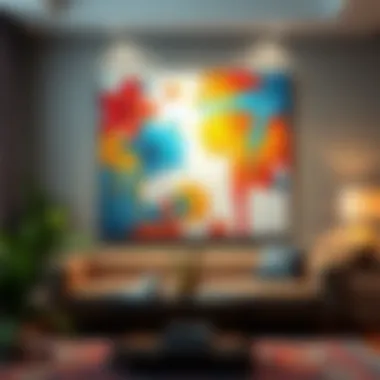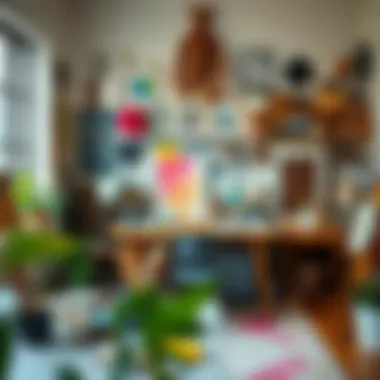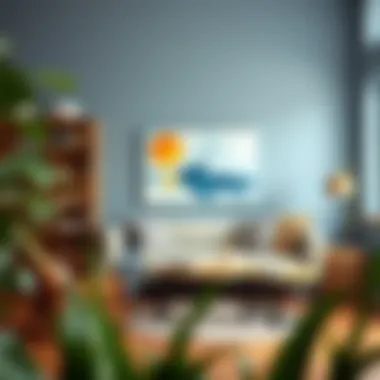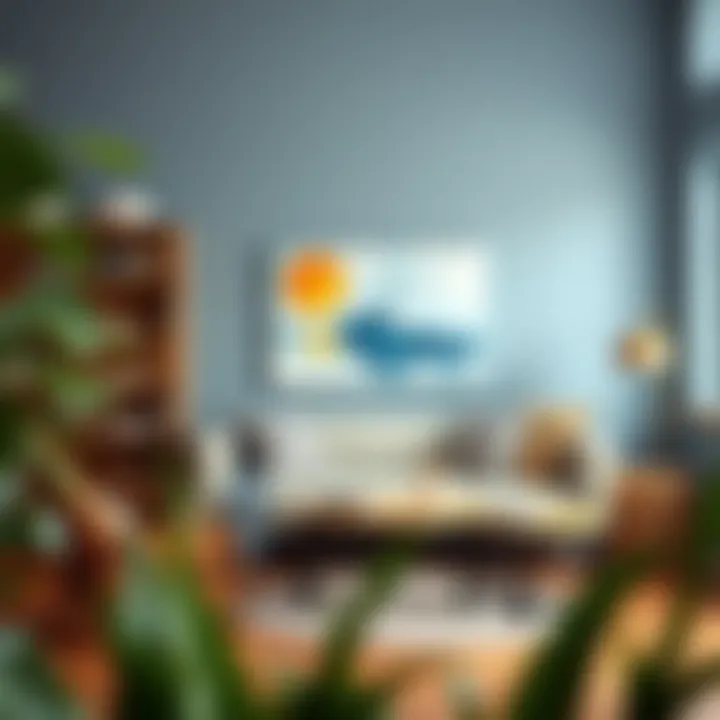Creative Painting Projects for Teens: A Guide


Intro
Art has long been a vessel for self-exploration, and painting stands as one of its most powerful forms. For teenagers, the canvas is more than just a surface; it is a realm where the strokes of a brush echo their unarticulated thoughts and dreams. The importance of painting crafts in cultivating a teenager's creative spirit cannot be understated. With each hue, they narrate their story, forging connections, discovering identities, and confronting emotions that often remain hidden in everyday life.
This exploration goes beyond mere aesthetics; it taps deeply into the psychological and developmental benefits that painting offers. Engaging in artistic endeavors cultivates patience, encourages problem-solving, and enhances fine motor skills. Moreover, as teens dabble in different techniques and materials, they foster a sense of achievement and confidence—qualities that extend far beyond the easel.
Join us as we embark on a journey that highlights a myriad of painting projects perfect for various skill levels. This article aims to equip parents and educators with the insights needed to nurture the budding artists in their lives. Whether it's through abstract expressions or realism, the art world is a vibrant backdrop for young imaginations.
The Importance of Painting in Teen Development
Painting serves not just as a hobby but as a critical avenue through which teens can develop essential skills. Engaging in artistic endeavors such as painting broadens the horizons of adolescent exploration, enabling them to confront complex emotions, enhance cognitive function, and nurture their creative spirit.
Cognitive Growth through Art
Incorporating painting into a teen's routine can significantly bolster cognitive growth. When young individuals immerse themselves in art, they learn to visualize, plan, and execute their ideas on canvas. Techniques such as perspective, color theory, and form require a thoughtful approach to spatial relationships, encouraging analytical thinking. For instance, when a teen works on a landscape painting, they must decide how to represent depth and realism, which promotes critical reasoning.
Furthermore, engaging with art enhances focus. A child’s mind flits from one thought to another, but painting demands sustained attention. The process fosters patience and perseverance, as it often takes several attempts to get things just right. This sort of dedication translates well into academic environments, where concentration is key. Moreover, studies suggest that involvement in the arts can improve memory recall and problem-solving skills.
Emotional Expression and Communication
Teens often grapple with emotional turmoil, struggling to articulate their feelings in words. Painting offers an outlet for expression that verbal communication might not. The brush strokes, colors, and shapes become a language of their own, allowing teens to channel feelings of joy, sadness, or even confusion onto a canvas.
Choosing the Right Materials for Painting Projects
Selecting the right materials can make all the difference in a teen's painting experience. It’s like laying down the foundation for a house—if that’s not solid, everything else is just a house of cards. Having the appropriate supplies not only helps in executing creative ideas but also empowers teens to explore their artistic abilities without frustration. When a young artist uses quality materials, it enhances their confidence and results in a far more satisfying outcome. Let's break down the essentials to equip our budding painters for success.
Essential Supplies for Beginners
When starting out, it’s crucial to have the basic supplies that form the backbone of any painting project. Here’s a quick list:
- Paints: Beginner sets of acrylic or watercolor paints are ideal for ease of use and clean-up.
- Brushes: A variety of brush shapes and sizes can help teens achieve different effects.
- Palette: Simple plastic or wooden palettes serve as a mixing station for colors.
- Water container: For cleaning brushes and mixing watercolors.
- Rags or Paper Towels: To wipe excess paint and keep the workspace tidy.
Beyond these basics, it's helpful to invest in aprons or old shirts to keep clothes safe from unexpected splatters. Having the right supplies also fosters a sense of seriousness and commitment to the craft.
Understanding Different Paint Types
Grasping the various types of paint can feel a bit like deciphering a foreign language. Each type brings its own set of characteristics.
- Acrylic Paint: This dries quickly and is very versatile. It’s also water-resistant once dry, making it a go-to for many artists.
- Watercolor Paint: These paints require a bit more finesse. The colors can be transparent, allowing for layering effects that create depth.
- Oil Paint: While not typically recommended for beginners due to longer drying times, they offer rich colors and blend beautifully.
Selecting the right paint depends on the teen's comfort level and the project in mind.
Selecting the Proper Tools
Choosing the right tools is like finding the perfect toolkit for a mechanic. If the tools are wrong, the job can quickly go south. Here are some essential items to consider:
Brushes and Their Varieties
The selection of brushes can either enhance or hinder a young artist's creativity. Brushes come in various shapes—round, flat, filbert, and fan, each serving a different purpose. For instance, round brushes are fantastic for detailing, while flat brushes are better for broad strokes. Choosing the right brush size also matters; a smaller brush might be needed for intricate spots, while a larger one would be great for covering more extensive areas.
"Using a brush suited to the technique can significantly impact the artistic expression."
Moreover, synthetic brushes are a popular choice among beginners because they are typically less expensive and more durable than their natural hair counterparts.
Canvas vs. Paper
Selecting between canvas and paper can feel like deciding between two equally delicious desserts. Canvas holds up well with lots of paint, making it ideal for oils and acrylics, but it can be more costly. Conversely, paper—especially watercolor paper—tends to be more forgiving for mistakes but may not handle heavy applications of paint as well. Teens should consider what type of artwork they want to create when making this decision, as it could affect not only the final product but also their experience.
Palettes and Easels
Lastly, palettes and easels play vital roles in creating an effective workspace. A palette is where the color magic happens—mixing and blending hues before applying them. It's crucial that it’s easy to clean, as leftover paint can complicate future color mixing. For easels, they encourage proper posture while painting, which can be quite beneficial during longer sessions. It can be a foldable one for small spaces or a more sturdy freestanding easel, catering to different needs and preferences.


Each of these tools has its own unique contribution. With the right choices in brushes, canvases, and easels, teens are not just painting; they are forging their paths into the world of art.
Fundamental Painting Techniques for Teens
Understanding fundamental painting techniques is crucial for teens venturing into the world of art. These techniques form the backbone of the artistic process, guiding young artists in expressing their creativity effectively. By mastering these methods, teens can explore their potential, experiment with styles, and gain confidence in their artistic abilities.
Brush Techniques
Brush techniques are fundamental as they directly influence the outcome of a painting. Let's delve into three essential methods that every budding artist should understand.
Dry Brushing
Dry brushing involves using a brush with minimal paint. This technique contributes to texture and depth in the artwork. The key characteristic of dry brushing is its ability to produce a rough, dry look, which is effective in representing various surfaces like wood or stone.
One unique feature is its ability to create subtle variations in tone without overwhelming colors. However, it requires practice to avoid making the artwork appear too scratchy. Nonetheless, its popularity stems from its versatility and ease of use, making it a beneficial choice for teens looking to enhance their texture skills.
Layering
Layering is a powerful technique that allows artists to build depth and complexity in their work. It involves applying multiple layers of paint to achieve a richer composition. The essential element of layering is its capacity to blend colors while changing their opacity.
This method encourages experimentation with color mixing, enhancing visual interest. Its unique attribute lies in how it allows mistakes to be covered up, which can lead to delightful surprises. While it requires patience, the resulting depth and vibrancy often outweigh the challenges, making it a favorite among young artists.
Washing
Washing is a technique where a diluted mixture of paint is applied to a surface. This method teaches teens how to create soft, flowing backgrounds or subtle color transitions. The primary characteristic of washing is its light coverage, making it perfect for creating atmosphere in a painting.
A unique feature of this technique is that it can easily dissolve and blend into other colors, producing smooth gradations. However, one disadvantage is that it can wash away details if overdone. Still, its effectiveness in achieving mood and ambiance makes washing a valuable technique for any teen artist still finding their style.
Color Mixing Basics
Color mixing is essential for creating depth and life in paintings. While many might think color comes straight from the tube, the real magic lies in understanding how to blend colors harmoniously. Teens will learn to grasp the color wheel better, recognizing primary, secondary, and tertiary colors.
This understanding drives experimentation, as mixing colors can yield unexpected yet pleasing results. Not only does this ignite creativity, but it also helps in developing a keen eye for color relationships. Simple exercises, like creating a color gradient or experimenting with complementary colors, can vastly improve their painting skills.
Understanding Light and Shadow
Light and shadow play an essential role in painting by adding volume and dimensionality to a flat surface. Grasping this concept helps teenagers make their artwork more dynamic. Teens should explore how light interacts with different surfaces and how shadows can enhance the overall composition.
A practical approach is to observe objects in real life, noting where the light hits and creates shadows. They might achieve this through exercises such as painting still life setups, which provides firsthand experience in rendering shadows and highlights. Ultimately, mastering the interplay of light and shadow significantly elevates a teen's artistic expression, making the work feel more grounded in reality.
Engaging Painting Craft Projects for Teens
When discussing painting crafts for teenagers, engaging projects take center stage. These projects not only ignite creativity but also serve as a vessel for expression in a world where teens often feel unheard. By diving into engaging painting crafts, teenagers can explore their personalities and feelings, oftentimes finding solace and joy through these creative outlets.
Abstract Canvas Art
Abstract canvas art operates under the principle that art doesn’t always have to depict the observable world. Instead, it emphasizes shapes, colors, and forms with no direct representation. Teens are encouraged to splash color in a way that feels right to them, allowing personal interpretation to shine through.
Consider setting a timer for 15 or 20 minutes. During this time, use brush strokes of all kinds, from circular to squiggles, layering colors and textures. This method encourages them to think outside the lines—literally. One important benefit here is that being abstract allows for enormous freedom. If a teen feels anxious about making "something perfect," abstract art offers a refreshing break from those boundaries. It’s like telling them: "Hey, it’s okay if it looks like a splash rather than a masterpiece."
"Art enables us to find ourselves and lose ourselves at the same time."
— Thomas Merton
Themed Mural Creation
Creating a mural can serve as a profound method of collaboration. This project not only allows for artistic growth but also promotes teamwork among peers. When working on a mural, teens can address themes that are important to them—social issues, personal stories, or even favorite books or movies!
Choosing a wall space, preferably an area frequented by others, can offer a sense of purpose to the project. Break down the mural into sections, assigning themes or images to groups, making the task feel less daunting and more manageable. This method can nurture communication skills as they discuss and negotiate design choices, reinforcing the social aspect of painting.
Custom T-Shirt Design
Custom T-shirt design is another exhilarating avenue for expression. Teens get a chance to create wearable art, capturing their unique styles and preferences. Working on T-shirts allows them to explore textile paints or fabric markers. The first step is sketching designs on paper before transferring them onto the fabric, ensuring clarity in their vision.
One could focus on themes that reflect their interests—band logos, phrases, or caricatures. Incorporating elements like stencils or tie-dye techniques can add flair and variety, producing one-of-a-kind garments. Not only does this project encourage creativity, but it also provides a sense of accomplishment when they see strangers wearing their creations!


Mixed Media Collages
Mixed media collages are an exciting blend of various materials and techniques. This approach encourages teens to combine paint with other materials like magazines, fabric, or scraps of paper. Using this layering process, they can express multiple facets of themselves, merging words, images, and colors to tell a story or evoke emotion.
Start by selecting a theme or concept. Then gather materials—a magazine cutout here, a painted scrap there. Encourage experimentation; they might discover attachments and observations they never realized they had. The beauty of mixed media is that there are almost no mistakes—each piece is valid and contributes to the whole picture.
Engaging in these painting craft projects not only enhances a teen’s skills but also establishes a nurturing environment for expression, creativity, and self-discovery.
Building a Productive Painting Environment
Creating an environment conducive to painting is crucial for teens to thrive in their artistic endeavors. A productive painting environment can be the difference between a moment of inspiration and artistic block. The right space not only inspires creativity but also aids in organization and focus. A well-planned setting encourages exploration and expression, essential elements for any budding artist.
Designating a Creative Space
Choosing the right spot for painting is fundamental. This space should be a area where teens feel relaxed and free to create without interruptions. Ideally, it should be well-lit, preferably with natural light, as it boosts mood and maintains energy levels. The key is to make it personal. For example, hanging artwork that resonates with them, or having a few plants around can breathe life into the area.
Importantly, this space shouldn’t be too cluttered. It’s easy to lose sight of inspiration surrounded by chaos. A simple setup with a dedicated table for painting, perhaps near a window, could work wonders. Having their own corner, even if it’s just a small desk, can foster a sense of ownership, giving them the space to truly delve into their art.
Organizing Art Supplies
Once the space is designated, the next step is organizing art supplies. A messy workstation can lead to frustration and loss of creative flow. It’s essential to categorize supplies so that they are easily accessible. Here are a few suggestions:
- Use Clear Containers: This enables easy identification of materials. Each container can be dedicated to specific supplies like paints, brushes, and canvases.
- Labeling: Simple labels help in keeping track of what’s where. For instance, easily finding watercolors vs. acrylics can save precious time during a creative burst.
- Vertical Storage: Consider utilizing wall-mounted shelves or pegboards to store supplies. This not only saves space but also keeps the workstation tidy.
A structured approach to supplies can minimize distractions and enable a better focus on the creative process.
Inspiring Visual References
Visual references play a significant role in any artistic journey. They can ignite inspiration and provide ideas that teen artists may want to explore in their work. One effective method is to create a mood board. This involves pinning images, color schemes, or even textures that resonate with their artistic vision. Digital platforms like Pinterest or even simple physical boards in the creative space can serve this purpose well.
Furthermore, exposing them to various art styles and famous artists can also broaden their artistic horizons. Visiting local galleries or even exploring websites like Wikipedia or Britannica to learn about different techniques can be a great addition to their reference materials.
Having a dedicated creative space allows for the flow of ideas and encourages teens to express themselves freely. It fosters a sense of belonging that is integral for artistic growth.
In essence, building a productive painting environment goes beyond just physical space; it’s about creating a nurturing environment where young artists can flourish. The right conditions can lead to not only artistic development but also personal growth, as each painting reflects their journey and experiences.
Collaborative Painting: Engaging with Others
Engaging in collaborative painting offers a rich landscape for teens to explore art in a vibrant, social context. It's not just about strokes on canvas; it’s about building relationships, fostering teamwork, and enhancing communication skills. When young artists come together, they bring diverse perspectives, encouraging a melting pot of ideas that can lead to innovative creations. Working collaboratively helps teens develop a sense of community, making them feel less isolated and more connected to their peers.
Art Groups and Community Projects
Art groups serve as a vital incubator for creativity. By joining an art group, teens can experience a true sense of belonging. These groups often organize community projects that provide opportunities for collaborative painting. Such projects allow participants to address specific themes or issues in their local community, enabling them to visualize their thoughts through collective artwork.
Benefits of engaging in art groups include:
- Enhanced Social Skills: Painting with others promotes interaction and teamwork. Teens learn to communicate better and share vision.
- Broadened Horizons: Exposure to different painting styles and techniques from peers can deepen understanding and appreciation for various forms of art.
- Motivation and Accountability: An art group can create a healthy sense of competition and motivation. When you see your peers creating, it can inspire you to push your limits.
A community mural project is a prime example of collaborative painting. Participants come together to design and create a mural that reflects their shared experiences and cultural heritage. This not only beautifies the space but also strengthens community bonds.
Hosting a Painting Party
Hosting a painting party can transform a casual gathering into a memorable artistic experience. Such events encourage teens to express themselves while having fun with friends. This kind of collaboration cultivates an environment where experimentation is encouraged, leading to surprising artistic outcomes.
To organize a successful painting party consider these key aspects:
- Theme Selection: Choose a theme that resonates with the group. This could range from simple things like nature scenes to more complex ideas like abstract concepts.
- Supply Management: Make sure you have ample supplies, including canvases, brushes, paint, and aprons to keep clothing clean. To avoid chaos, set up painting stations ahead of time.
- Guidance and Instructions: Consider having a more experienced artist guide the party. This can help ease the initial awkwardness and give participants some helpful tips.
- Encourage Freedom: Allow attendees enough freedom to personalize their projects. This ensures each participant can express their vision while still contributing to a collective piece.
"Collaboration isn’t just about working together; it’s about crafting a shared vision and enriching each other's artistic journey."
Painting parties not only enhance creativity but also build bonds among participants. When teens engage in shared artistic endeavors, they often step out of their comfort zones, learn new skills, and create lasting memories.


As young artists become more engaged in the collaborative painting process, they benefit personally and gain a deeper understanding of their role within a community. Whether through formal groups or informal gatherings, the essence of collaborative painting is transformative, making it essential in the realm of teen development.
Showcasing Teen Artwork
Showcasing teen artwork is an essential aspect of nurturing creative talents among young artists. By providing them with a platform to present their artwork, teens can enjoy numerous benefits. It cultivates confidence, fosters a sense of achievement, and creates an opportunity for connection among peers and the larger community. This section will delve into two main ways to showcase teen artwork: organizing art exhibitions and utilizing online platforms for sharing.
Organizing Art Exhibitions
Creating a physical space to display teen artwork can be incredibly rewarding. Art exhibitions often captivate the attention of families, friends, and even the public, providing recognition for young artists. Organizing such events takes some thought and effort but can be structured in manageable steps:
- Choose a Venue: Finding the right place to host an exhibition is crucial. Local community centers, libraries, or even school facilities can be suitable options.
- Secure Permissions and Sponsorships: It's vital to obtain any necessary approvals and consider seeking sponsorships from local businesses. These partnerships may provide resources and promote engagement within the community.
- Plan the Layout: Thoughtful consideration must be given to how the artwork will be displayed. Organizing pieces by theme or color can create a cohesive flow throughout the space.
- Marketing the Event: Get the word out! Utilize flyers, social media, and email newsletters to announce the exhibition. Engaging the community beforehand generates interest and encourages attendance.
- Engage the Audience: During the event, encourage artists to discuss their work. Providing an opportunity for teens to connect with patrons can enrich the experience and deepen their appreciation for their craft.
Art exhibitions serve not only as a means to showcase artistic talents but also as venues for genuine human connections, where art becomes a bridge between creators and viewers.
Utilizing Online Platforms for Sharing
In today’s digital age, online platforms offer a dynamic space for sharing artwork. Teens can reach wider audiences through social media, blogs, and online galleries. Here’s how they can effectively showcase their work online:
- Social Media: Platforms like Instagram and Facebook allow teens to create a portfolio easily. Posting regularly helps maintain engagement and visibility.
- Art-Focused Websites: Websites such as DeviantArt or ArtStation allow artists to create an enticing online presence. These platforms are tailored for artists and provide community feedback, fostering a sense of belonging.
- Blogs and Personal Websites: Teens can take initiative by starting their own blogs or personal websites. This independent approach allows for creative expression beyond just artwork, like sharing thoughts about the creative process.
- Online Competitions and Challenges: Participating in these events can boost visibility and offer potential awards. Websites often host themed competitions that can ignite creativity and showcase talent.
Sharing artwork online can have a broader reach, connecting teens with fellow artists and audiences from all over the world. Additionally, it helps cultivate networking opportunities and constructive feedback, essential for artistic growth.
By showcasing their work, teens can transform self-doubt into self-confidence, paving the way for future endeavors in the art world.
In summary, showcasing teen artwork is a critical step in their artistic journey. Whether it’s through organized exhibitions or utilizing online platforms, every opportunity to share art encourages ongoing development and fosters a rich artistic community.
The Therapeutic Aspects of Painting
Art isn't merely a canvas covered in colors; it's a profound means of personal expression, especially for teens navigating the complexities of growing up. Painting offers multiple therapeutic benefits, making it an important aspect of adolescent development. Through this section, we will discuss how engaging in painting can support mindfulness, promote relaxation, and provide an emotional outlet for teenagers.
Mindfulness and Relaxation Techniques
When teens dabble in painting, they often enter a tranquil state, one where worries dissipate, if only for a moment. This form of mindfulness allows them to be fully present, focusing on the strokes of their brush or the blend of colors on their palette. Techniques such as deep breathing can be paired with painting sessions, enhancing the relaxation aspect. Encouraging teens to take slow, deliberate breaths while painting can help ground them, creating a serene atmosphere.
Using painting as a mindful practice might involve setting a specific time each week for creativity. Lighting candles or playing soft music can create an environment conducive to relaxation. Teens are encouraged to put away their mobile devices during this time, focusing solely on the act of creating.
"By evoking focus and stillness, painting becomes a sanctuary where the chaos of adolescence meets the calmness of creativity."
The act of mixing colors, watching paint flow, and seeing a piece come to life can be a soothing process, akin to meditation. Through repetition and engagement, they learn to navigate their feelings, leading not only to a state of calm but also to a clearer mindset.
Emotional Benefits of Creating Art
Creating art, especially painting, acts as a conduit for emotional expression. Teens often find it difficult to articulate their feelings verbally. Painting provides a canvas for emotions that might otherwise remain unexpressed. Whether it's joy, frustration, or sadness, every brushstroke can symbolize a feeling, offering a unique pressure valve for mental strain.
Moreover, studies have shown that engaging in artistic activities can boost self-esteem. As teens witness their creations unfold, they may experience a sense of accomplishment. This pride can be particularly valuable during a tumultuous stage of life when self-doubt is prevalent.
It's essential for parents and educators to recognize the emotional weight of painting, not just as a hobby or pastime but as a legitimate form of emotional outlet. Encourage teens to keep an art journal. Documenting feelings alongside artwork can be a powerful approach to self-reflection.
In summary, the therapeutic aspects of painting present profound opportunities for teens. Beyond fostering creativity, painting acts as a bridge to mindfulness and emotional well-being, equipping them to face life's challenges with a clearer mind and a more balanced heart.
End: Embracing Creative Expression
As we wrap up this exploration into the world of painting crafts, it's clear that the journey through artistic expression is not merely about creating visually pleasing images. This venture resonates deeply with the developmental phases of teenagers. Engaging in painting allows adolescents to harness their emotions, enhance cognitive abilities, and articulate thoughts that may often remain unspoken. Art becomes a bridge, connecting them to their inner selves and enabling communication with the outside world.
Reflecting on the Value of Art
The significance of art in a teen's life cannot be overstated. It cultivates a myriad of skills that linger much beyond their teenage years.
- Cognitive Development: Teens engaging in painting learn problem-solving skills through color mixing or deciding on the right techniques for their project. Such choices require critical thinking and strategic planning.
- Emotional Benefits: Painting allows teens to process feelings, sunny or stormy. Whether it's exhilaration or distress, bringing these emotions to canvas provides relief and understanding.
- Social Connections: Another crucial aspect is how art fosters relationships. Group projects can lead to bonding, promoting teamwork among peers who might otherwise stroll through life in their bubbles. To put it simply, art nurtures not just the individual but also the community that surrounds them.
Art is not freedom from discipline, but disciplined freedom. – Anonymous
Encouraging Lifelong Artistic Pursuits
Encouraging a practice of art from a young age sets the groundwork for lifelong engagement with creative outlets. The skills a teen acquires do not vanish upon reaching adulthood; they often evolve into hobbies or even careers.
- Nurturing Interests: If a teen shows even a hint of interest in painting, nudging them towards workshops or mentoring can lead to an abiding relationship with art. This journey might start with acrylics on canvas but might twist into web design, photography, or even architecture down the line.
- Integration into Daily Life: Making art a regular feature, even if it's doodling in a notebook during a lecture or painting room decor, enhances their life quality. This continuous engagement with creativity fosters well-rounded personalities.
- Celebrating Each Milestone: Whether it's sharing art on social media platforms or displaying it at home, recognition boosts their confidence. A simple 'your work is beautiful' can do wonders.
For more insights on the educational benefits of art, visit Britannica or explore community programs available through Youth Art Foundation to further engage with the value of artistic initiatives.



